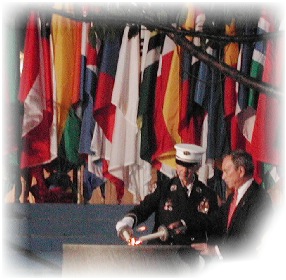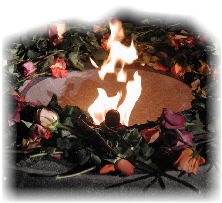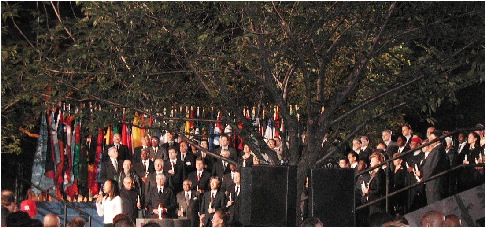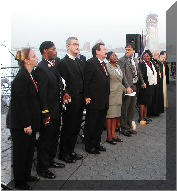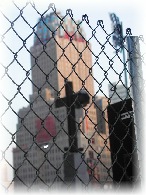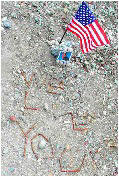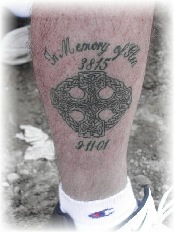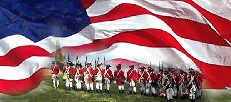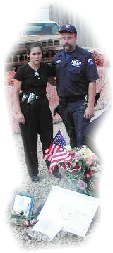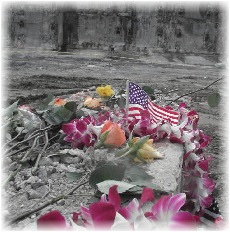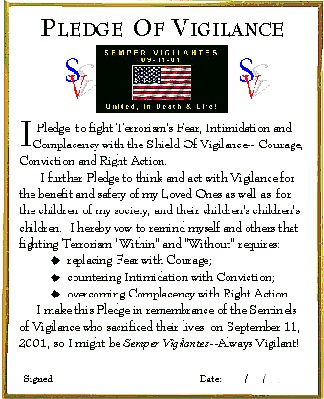|
 VigilanceVoice
VigilanceVoice
.jpg)
VigilanceVoice.com
Thursday--September
12, 2002—Ground
Zero Plus 365
___________________________________________________________
Tomb Or Garden Of Vigilance?
___________________________________________________________
by
Cliff McKenzie
Editor, New York City Combat Correspondent News
GROUND ZERO, New York
City, September 12-- Last night I put my hands over the Eternal Flame
of Vigilance and let the heat of its passion for peace warm my belief in
the Sentinels of Vigilance.
Just minutes before, ninety
members of the United Nations stood on the platform in Battery Park as
Mayor Bloomberg lit the flame, an eternal memory to those who died in the
September 11 Terrorist attack.
While thousands stood across the street, craning
to see what was happening, my wife I were privileged to be with the
families, in a private yet unqualified signal of global unification
against Terrorism.
The Eternal Flame was lit next to the
wounded sphere that survived the World Trade Center attack.
The 'Sphere', weighing 45,000 pounds of steel and
bronze, 25 feet high, was sculpted by Franz Koenig as a symbol of peace in
1971. It stood in the WTC Plaza for 30 years.
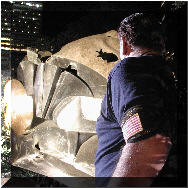 |
Even the Terrorist attack
couldn't destroy it. Scarred, wounded, it survived.
Koenig's sphere was put in Battery Park after September 11--the first
monument to the enduring nature of Peace over War, of Vigilance over
Terrorism.
The sphere was a
fitting backdrop to the 90 members of the United Nations who participated.
Standing before us was the most powerful body of world government,
assembled to pay tribute to America's loss, and by default, to issue a
message to Terrorists around the world that unity would defeat them.
The procession was led by
Secretary of State Colin Powell; it was book ended with the Secretary
General of the United Nations. The U.N. members stood like a
choir, on tiers in front of the Eternal Flame while "God Bless America"
was sung.
It was a beautiful end to a long day that started
at 3:45 a.m. when the alarm rang, reminding me a year before I had been at
the epicenter of a new wave of history.
In the dim light of the morning, we caught the
"N" subway to Lower Manhattan. New York City never sleeps, so
we weren't alone. We got off at City Hall and walked
past the tributes that drape the front of Trinity Church. Trinity is
the headquarters of memorabilia sent from around the world, messages of
condolences and support to the loss of so many that day.
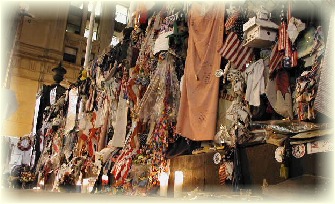 |
In the pre-dawn I felt one
with the messages written by children, the flags, the shirts, the poems,
the heartfelt passions of the soul that people of all ages, from all
lands. Thousands of cranes, symbolizing peace, hung on the wall, and
pre-dawn volunteers were busy arranging new tributes and gifts next to old
ones, weathered and worn over the past year.
We made our way to Robert Wagner
Park, overlooking the bay where the Hudson and East Rivers meet. The
sunrise services faced the Statue of Liberty; its dim sallow flame could
be seen in the distance. The service was ecumenical, with a
host of religions represented--a Buddhist monk, a Greek Orthodox
priest, a Jewish rabbi, a Roman Catholic priest, an Islamic chaplain from
the FDNY, a Baptist minister, and the head of the Trinity Church delivered
messages. Local politicians were there, of course, to remind
everyone that Church and State stood side by side, but they didn't
overshadow the spirituality of the event.
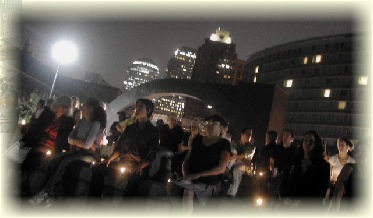 |
We all held candles
in the dim light, and listened as each speaker recited a poem or a piece
of scripture as ferry boats gunned their engines, shuttling workers
from New Jersey to Lower Manhattan. The glow of the Statue of Liberty's
torch grew fainter on the horizon as the sun slowly rose to create the
Dawn of Vigilance.
Then it was off to Ground Zero for
the tribute to those who had perished, and to those who had toiled to
search for the lost and rebuild the blood-soaked soil.
We elected not to join the family
group at first, and instead entered a private section reserved for the
construction workers--the men and women who dug through the rubble--the
grave diggers--the grunts of Nine Eleven. They were the tough,
the Marines of Vigilance, who scooped the debris into tens of thousands of
trucks after each shovelful was searched for bodies, or fragments that
might identify the loss of a loved ones.
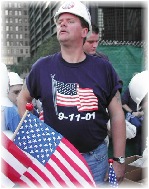 |
Many were steel and iron
workers, others, electricians or engineers. They carried their union
banners, American Flags. Most wore hard harts with stickers
plastered on them to let the world know they had spent the past year
sifting through the rubble of one of America's worst disasters. They
were the garbage men of Terror, cleaning up the site so upon its floor
another monument could be built.
In front of us was an iron cross
the workers had fashioned into a cross. It was made out of twisted
steel girders, crude in its design, yet as beautiful as anything da Vinci
might have molded. It symbolized the strength and belief of those
who survive the aftermath of horror, and while Christian in nature, was
ecumenical in effect.
The construction workers had found many bodies,
and placed wreathes on the fence in remembrance.
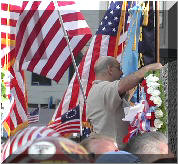 |
One man climbed up amidst a
swirl of flags to tie them on the galvanized links of the fence to the
cheers of the workers pressed together like sardines in a can.
As the ceremonies began, we decided to join the
families, and made our way down the street to the family section.
We had come to pay tribute to my friend, Emily's brother, photographer
William Biggart, the only correspondent to die in the holocaust.
We also came to share our own private feelings with the Spirits of
Vigilance to whom we had paid tribute each day for the past year on this
website. In our minds, we had earned the right to be "family."
We were given Hawaiian leis as we entered; a red
ribbon was pinned over our hearts, symbolizing us as members of the
survivors.
Ground Zero is a giant hole. A gargantuan
grave site. It is sixteen acres in size, and more than 60 feet deep.
It took 108,000 truckloads to move the debris from the site, a total of
1.8 million tons of earth (equaling 3.6 billion pounds). In modern
terms, it ranks as one of the largest graves in history, and once one
enters it, the walls of the "grave" close in, reminding you that it is not
a mere "hole" in the ground, but rather a tomb, a crypt, a depository of
death.
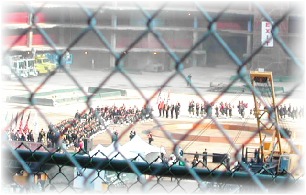 |
Before entering the site we
watched bagpipers marching in a circle representing the closure of the
events of a year before. They had marched all night from New York's
boroughs, starting at 2 a.m. in the morning from Queens, Staten Island,
the Bronx, Brooklyn and Manhattan, playing their soulful notes to let the
world that slept know the Vigilant never sleep. The pipers converged
on Ground Zero at 7:30 a.m. and made their way down a long gangway into
the pit below.
It was windy. Gusts whirled the dust
awakened by the piper's feet, throwing it up into the air to be whipped
into a whirlwind that cast a pall over the pit, as though those resting
below were disturbed by the presence of others, agitated by commotion and
media trying to memorialize the immemorial.
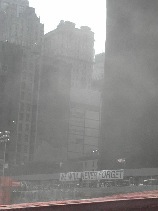 |
New York Governor Pataki read the
Gettysburg Address, and former Mayor Giuliani began reciting over 2800
names of those whose identities had been confirmed as dead.
President Bush spoke from the White House as the church bells tolled.
Then we were allowed down the long ramp to pay our respects.
I come from a long line of grave diggers.
My father and his father were morticians, and ran the Anderson Funeral
Home in Hood River, Oregon. My real name is Anderson, I was
adopted by my step-father, and never met my real father until I was 21,
but I always knew who he was, and what he and his family did for a living.
Oddly, I felt at home in the pit.
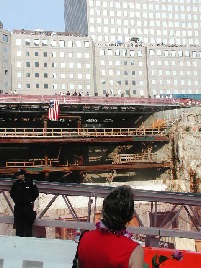
|
But no matter how
many graves one has seen, Ground Zero was intimidating. As we
reached the bottom of the ramp and made our way around the vast cavern in
the ground, the wind whipped wildly, slinging particles of dirt into our
pores, stinging our eyes, covering us with an earthy ash not unlike the
ash that had blanketed me on September 11, 2001. My eyes stung and
what might have appeared as tears was my body's attempt to wash the dust
free. I thought back to a year ago when I was just a few blocks from
the collapsing buildings, and their pulverized debris drenched me with the
ash of death.
We made our way to the "memorial ring" and placed a rose for William
Biggart, Emily's brother, and a man who had become my quasi-brother over
the past year.
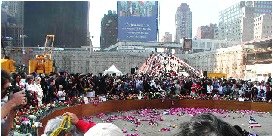 |
He and I had rushed to Ground Zero a
year ago, I to write, he to take pictures. I survived, he
didn't. I had never met Bill Biggart, but I knew him through
Emily. I knew how close she was to her brother, how proud she was of
him and also how frustrated she was that he had put himself at risk and
paid the final price.
I was acting as her proxy, paying tribute
to Bill for her, an agreement we had made earlier in the week as she
preferred not to revisit the pain and suffering of her loss.
My wife and I walked reverently around the gaping
hole. Priests, ministers, rabbis and Red Cross Workers were
stationed to support those who needed comfort.
I felt I was in the soul of a giant
whose insides were empty, stripped of its humanness, barren of its life
force. The pit felt like an empty womb without a uterus,
scooped clean, waiting to be filled with life but angry at the presence of
life trampling upon its barren sanctuary.
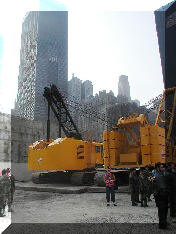
|
The smell of grease
smacked my nostrils. A giant crane lay at rest, and machinery
used to carve the earth bare of any scars of the past seemed to wait for
us to leave so they could finish what they had started and move on to the
next job.
Sections of the ground were wet from seeping
water. Mud sucked at your shoes when you tried to step over
them and missed dry land. Chunks of concrete stood in southeast
section of the pit, scarred reminders of the fortress that once had been
supported two 110-story buildings that rose nearly a quarter of a mile
high and housed 10 million square feet of the world's financial center.
But the sides of the
pit told the real story. Rusted steel veins extruded from the
stained concrete. They were metal arteries that had once helped hold the
building up. The protrusions angled upward at 45 degrees like mouths
of old canons aimed at the sky.
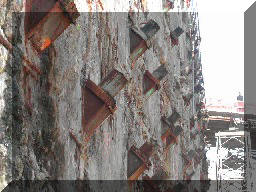
|
I shot pictures of it, awed by
the bloodlike stains scarring the walls. In one area a geyser of water
showered down from a giant culvert many feet above my head, baptizing the
parched earth below.
I stood below it and thought about the foundation of a
man's or woman's soul. I thought about the mission of the
Spirits of Vigilance, and how they were the engineers of a child's
infra-structure, coaches and mentors to help a child dig deep into the
roots of wisdom so when he or she grew, he or she could withstand the
sheer and stress of human emotions, human tragedies, and most of all,
human Terrorism.
I thought about how a child who is
neglected or abused, or grows up not feeling loved by his or her parents,
has shallow foundations. I thought about children who had no
one helping them dig their foundations for life, no one worrying about the
Fear, Intimidation or Complacency that rattle through a child's mind as it
seeks to find its way through the dark into the light. I
thought of a child who went to bed at night wishing his or her parents
would sit with them and "just talk," of someone who wants to know about
their "fears of the bogeymen" who hid in the closet or slipped into their
thoughts and told them they weren't worthy enough, smart enough, good
looking enough, popular enough, rich enough.
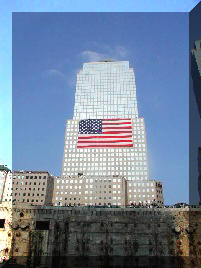 |
Critics of the World Trade
Center often forget the structures stood long enough for 24,000 people to
escape. They forget the foundations of the building saved
thousands, and that the memorial being held for just under 3,000 lost
souls could have been five times that amount.
I knew also that a parent who was too busy to spend
time with his or her child to get to know the child's foundations would
one day regret the fact when their child matured and the division between
them had grown too wide. I thought of a Parent of Vigilance as
an Architect of Vigilance, duty-bound to engineer in a child the power to
fight Fear's worst winds, to withstand Intimidation's angry dark clouds
and lightening, and to stand tall against Complacencies hurricanes.
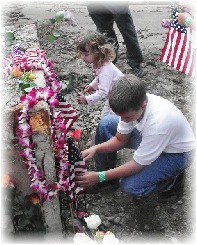 |
I watched the children planting
flower in the mud. Little girls and boys shoved the stems of
roses in the soft earth, trying to make them stand erect.
Their parents knelt with them, packing the ground, being part of the
children's building of their sense of respect for human life.
I knew I witnessed a precious moment in the architecture of the
children's humanness.
Families formed prayer circles and
bowed their heads solemnly. Makeshift crosses were fashioned
and messages such as "We Love You" were fashioned out of some old rusty
nails remaining on the pit's floor.
On the only standing remnants of a
shattered concrete wall people were writing messages to loved ones.
My wife wrote a message for Bill Biggart from Emily.
Red Cross volunteers moved about the crowd with
packages of Kleenex for those who needed to wipe tears from their eyes.
Pictures of loved ones were placed by flowers. Flags were placed by
flowers and photos.
The brother of one
policeman, NYPD officer, Glen Pettit, had a tattoo on his right leg, a
Celtic Cross in honor of his brother and Nine Eleven. I asked
his permission to take a picture of it. Tears rimmed the
family's eyes as they held up a picture of their son, husband, brother who
had given his life that day to help others.
As we explored the Tomb of Vigilance, the
sounds of names of the departed could be heard being read over a
loudspeaker, embellished by a cello playing a requiem. It
resounded in the pit, casting a pall over the hole that sliced through the
soul of all those there.
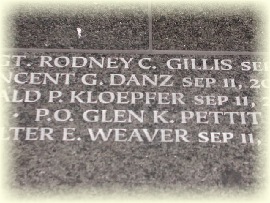 |
|
A portion
of the recent additions to the Police Memorial in Battery Park (note
Glen K. Pettit as mentioned above) |
I remembered my father's funeral.
I had gone after the services and stood over his grave. He had
abandoned me when I was nine-months old and only when I decided to contact
him at age 21 did we meet. I thought about his lack of presence in
my life. I thought about the Terror I experienced as a child
wondering why he didn't love me enough to send me a card, or pick up a
phone, or want to ever see me. I knew about the Terror of a child
who wasn't loved.
To me, my father's grave was merely a hole in the
ground. It had no feeling. It had no emotion. It was wet
the day we buried him in Oregon, and the bottom of the grave was saturated
in a foot of water. I stood looking at it, wondering how any mother
or father could live life without loving their child. I was glad the
children here this day were full of love for those they had lost.
I saw it in the way they planted the flowers, in the eagerness they
expressed to make the crosses stand straight, or the flower stand erect.
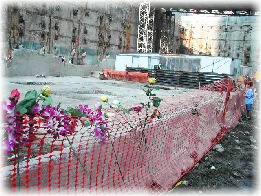
|
Then it dawned on me. For
so many, this wasn't a grave. This wasn't a hole in the ground.
It was a planter's box.
I realized the children were planting the " Seeds of
Vigilance" Children's fertile imaginations are limited by the
reality of adults.
When a friend of mine died last year, a man named Guy,
I had gone to his funeral and taken home a handful of dirt from his grave.
I stopped by my daughter's apartment and told her I had some dirt from
Guy's grave I was going to keep in fond memory of him. My
grandchildren, Sarah, then 3, and Matt then 5, had an "idea." They
took me into the garden behind their apartment and told me to give them
some of the dirt. Kneeling, they took the dirt and dug a hole, then
put the graveside dirt in it and covered it with fresh dirt. Then
they ran in the house and got some water and sprinkled it on top of Guy's
grave soil.
"What are you doing?" I finally asked, fascinated
by the ritual they had just performed.
"We're going to grow Guy back for you, G-Pa.
He was your friend, right? You would like him to come back, wouldn't
you?"
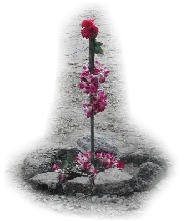
|
I wanted to cry. It
was so innocent, so beautiful. The children saw something I
didn't. They saw the birth of life from death, not its abortion.
So I realized the children who were planting the
flowers were planting "Stalks of Vigilance," seeding the soil so rich
verdant crop of Sentinels of Vigilance could grow out of the soil of
destruction.
A few days earlier I had read
about the battle of Brandywine, between British and American forces.
It was fought on September 11, 1777, and was one of the bloodiest in the
Revolutionary War. So many had died there that their bodies,
scattered over a 10 square mile area, enriched the soil. Over the
ensuing years the area produced the richest crops. The dead
had fertilized life.
I thought of the blood of the dead
from Nine Eleven as the fuel for life. If a child could believe it,
I could.
I chose to think of the Tomb of Vigilance no
longer as a gravesite, but as a Garden of Vigilance. It was no
longer just a hole in the ground.. It was a seedling box. A
big one.
From its depth would grow the Stalks of
Vigilance. I saw them sprouting rich greenery, lush beliefs,
and eternal security for those who chose to see Vigilance as crops of
Terrorism.
Whether it was a Tomb of Vigilance
or a Garden of Vigilance was up to those who viewed it.
As we left Ground Zero yesterday,
I chose to see it as the Garden of Vigilance.
I knew the children did.
I hoped the parents and loved
ones would too.

Go To September
11 - "The Dawn of Vigilance"
©2001
- 2004, VigilanceVoice.com, All rights reserved - a
((HYYPE))
design
|
|

.jpg)
